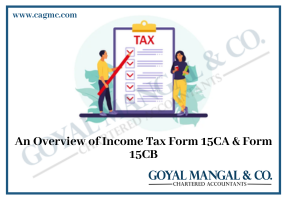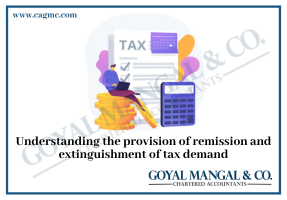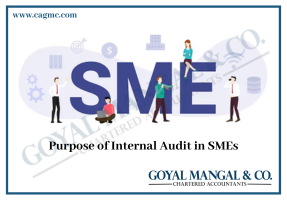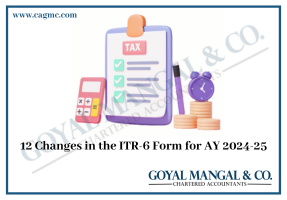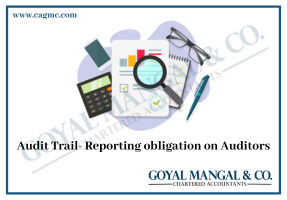
Income tax is an essential source of revenue for the government to meet the expenses of running the country. It is a legal obligation for every citizen to pay income tax on their income as per the income tax laws of the country. Taxpayers need to file tax returns and get them audited by a Chartered Accountant (CA) if their income exceeds a certain limit. The tax audit report is a critical document that provides details about the taxpayer’s income and tax liability. Under Clause 16(d) of the tax audit report, there are provisions for rectification for addition of income. In this article, we will discuss the rectification process for addition of income under Clause 16(d) of the Tax Audit Report.
Quick Look
Section 44AB mandating tax audit of accounts of business or profession was inserted by the Finance Act, 1984 and the Tax Audit Report Tax Audit Reports were furnished from the assessment year 1985-86 onwards. The benefits of getting the accounts audited were availed by all the stakeholders over the years. However, considering the compliance cost and ease of compliance, presumptive provisions were introduced from time to time. The benefit of presumptive provision could be availed only by declaring the presumptive income on mandatory basis when in reality the taxpayer may have incurred loss or earned income less than the presumptive income, deemed by the statute.
Let us briefly discuss about Clause 16(d) of the Tax Audit Report so that we could have the better understanding of the rectification of Income process.
Clause 16(d) of the Tax Audit Report
Clause 16(d) of the Tax Audit Report requires the tax auditor to report any additional income found during the audit of the taxpayer’s accounts. The Clause states that “whether the books of account and other records have been properly maintained and whether the financial statements comply with the accounting standards.” The tax auditor is required to report any additional income that is found during the audit, which was not declared by the taxpayer in their tax return.
Clause 16 of Tax Audit Report issued u/s 44AB of Income Tax Act, 1961 requires an auditor to report following details:
- Amounts not credited to the profit and loss account
- The items falling within the scope of Section 28
- The proforma credits, drawbacks, refund of duty of customs or excise or service tax, or refund of sales tax or value added tax, where such credits, drawbacks or refund are admitted as due by the authorities concerned
- Escalation claims accepted during the previous year
- Any other item of income
- Capital receipt
View on Clause 16(d) of Tax Audit Report
The disclosure in item (d) of Clause 16 is titled “any other item of income”. There is a controversy whether the Tax Audit Report since it is attracted to business or profession when the sales, turnover or gross receipt exceeds certain limit, certain incomes which are chargeable to tax under any other head need not be reported in this column.
Such of those reports where income from house property or other sources (like bank interest, dividend etc) do not get reported in Clause 16(d) and thus there is no addition or adjustment while processing the return under Section 143(1) by the Civil Procedure Code (herein referred to as “CPC”).
The other thought is that Section 44AB starts with expression “every person” carrying on business or profession shall get his accounts of such previous year audited by an accountant before the specified date and furnish by that date the report of such audit.
Taking a view that the audit under Section 44AB is not only for the books of account relating to business or profession and it is for the taxpayer, income chargeable to tax under the head ‘house property’, capital gains and other sources are also disclosed in Clause 16(d).
Majority of the Chartered Accountants believed that since audit report is issued under Clause 44AB, which talks about only business income, all other income earned by individual assesses which are not in the nature of business, like Savings Interest earned or PPF Interest or gain received on sale of mutual funds, etc. are not required to be reported under this Clause as the same are also not considered for deciding the tax audit limit.
There is another group which also does not report under this Clause but they add all other incomes even those not related to business as business receipts and then while filing return of income deduct the same from business income and show under respective head of incomes.
View in reference with Civil Procedure Code
CPC has considered sub-Clause (d) and sub-Clause (a) as one and the same. CPC believes that all the income reported under Clause 16(d) are business income falling under Section 28 which are not credited to Profit & Loss Account and has therefore added the total amount reported under the said Clause in Income earned from Profits and Gains from Business and Profession, thus leading to double taxation on such income. This difficulty was faced all Chartered Accountants who have reported under Clause 16(d).
What is Rectification for Addition of Income?
Rectification for addition of income is a process where the taxpayer can rectify any mistakes or omissions made by them in their tax returns regarding the declaration of their income. The rectification process allows taxpayers to revise their tax returns and declare the additional income that was not disclosed earlier. Rectification for addition of income can be done within four years from the end of the assessment year in which the tax return was filed.
The Rectification Process for Addition of Income under Clause 16(d) of the Tax Audit Report
The Rectification process for Addition of Income under Clause 16(d) of the Tax Audit Report is as follows:
- Step 1: Obtain the Tax Audit Report: The first step in the rectification process is to obtain the tax audit report from the tax auditor. The taxpayer needs to review the tax audit report and identify the additional income that was not declared in their tax return.
- Step 2: Prepare a Rectification Statement: After identifying the additional income, the taxpayer needs to prepare a rectification statement. The rectification statement should contain details of the additional income, the reasons for not declaring the income earlier, and the revised tax liability.
- Step 3: File the Rectification Statement: Once the rectification statement is prepared, the taxpayer needs to file it with the income tax department. The rectification statement should be filed online on the income tax department’s website. The taxpayer needs to attach a copy of the tax audit report and any other supporting documents.
- Step 4: Processing of the Rectification Statement: After filing the rectification statement, the income tax department will process the statement. The department may ask for additional information or documents before processing the rectification statement.
- Step 5: Issuance of revised Tax Demand: Once the rectification statement is processed, the income tax department will issue a revised tax demand. The revised tax demand will include the additional tax liability arising from the additional income declared by the taxpayer.
Available Options for Rectification for Addition of Income under Clause 16(d)
For rectification the options are as follows:
- Either you revise your audit report and file for rectification and your demand is sure to be removed.
- Another is rectification of return by using basic Mathematics.
Let us understand these two options in great detail.
- 1st Option
Ask the chartered accountant to revise their audit report and remove the amount reported under Clause 16(d). While very few chartered accountants would accept to revise their audit report, this is the definite way to remove your demand. After the revised audit report is filed by Chartered Accountant and approved by Assessee, file for Rectification by Reprocessing the return. Rectification order generally takes approximately 15 days to process the return.
- 2nd Option
You can also rectify the return by using basic mathematic as follows:
- Add the amount in PGBP Add the amount in Profits and Gains from business and Profession under Cell 5d of Table 5 of Schedule Part A – OI Other Information (mandatory if liable for audit under Section 44AB; for others, fill if applicable) This amount will also need to be reported under Schedule BP > Table A-From business or profession other than speculative business and specified business > Row no 23Any other item of addition under Section 28 to 44DA. This will Increase your Business Receipts.
- Amount reported under Other Taxable heads of Income Remove the amount taxable under other heads as “Income Reported under Other heads of Income”. Report the amount in respective head in row 3> of Table A From business or profession other than speculative business and specified business of> Schedule BP – Computation of income from business or profession
- For Exempted Income For incomes which are exempt from tax but reported under Clause 16(d) like Interest on PPF or Gold Interest or Agriculture Income, report the same under Row 5c > Table A From business or profession other than speculative business > Schedule BP Computation of income from business or profession All the steps put together shall revert the same result as what was originally filled in ROI.
Conclusion
Rectification for addition of income is an essential process that allows taxpayers to rectify any mistakes or omissions made by them in their tax returns. Taxpayers need to be aware of the provisions of Clause 16(d) of the Tax Audit Report and the rectification process for addition of income. The rectification process can help taxpayers avoid penalties and interest on the additional tax liability. It is advisable to consult a tax professional or a CA for guidance on the rectification process for addition of income under Clause 16(d) of the Tax Audit Report.

